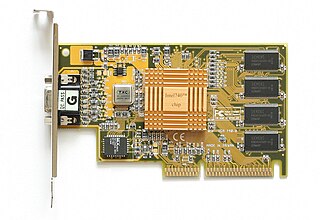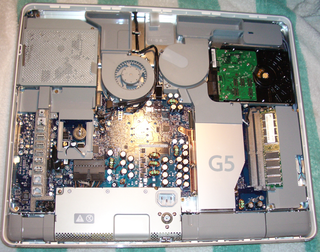
In computing, the expansion card, expansion board, adapter card or accessory card is a printed circuit board that can be inserted into an electrical connector, or expansion slot, on a computer motherboard, backplane or riser card to add functionality to a computer system via the expansion bus.
A video card is an expansion card which generates a feed of output images to a display device. Frequently, these are advertised as discrete or dedicated graphics cards, emphasizing the distinction between these and integrated graphics. At the core of both is the graphics processing unit (GPU), which is the main part that does the actual computations, but should not be confused as the video card as a whole, although "GPU" is often used to refer to video cards.

ATI Technologies Inc. was a semiconductor technology corporation based in Markham, Ontario, Canada, that specialized in the development of graphics processing units and chipsets. Founded in 1985 as Array Technology Inc., the company listed publicly in 1993. Advanced Micro Devices (AMD) acquired ATI in 2006. As a major fabrication-less or fabless semiconductor company, ATI conducted research and development in-house and outsourced the manufacturing and assembly of its products. With the decline and eventual bankruptcy of 3dfx in 2000, ATI and its chief rival Nvidia emerged as the two dominant players in the graphics processors industry, eventually forcing other manufacturers into niche roles.
A random-access memory digital-to-analog converter (RAMDAC) is a combination of three fast digital-to-analog converters (DACs) with a small static random-access memory (SRAM) used in computer graphics display controllers to store the color palette and to generate the analog signals to drive a color monitor. The logical color number from the display memory is fed into the address inputs of the SRAM to select a palette entry to appear on the data output of the SRAM. This entry is composed of three separate values corresponding to the three components of the desired physical color. Each component value is fed to a separate DAC, whose analog output goes to the monitor, and ultimately to one of its three electron guns.

The GeForce 6 Series is Nvidia's sixth generation of GeForce graphic processing units. Launched on April 14, 2004, the GeForce 6 family introduced PureVideo post-processing for video, SLI technology, and Shader Model 3.0 support.

Scalable Link Interface (SLI) is a brand name for a multi-GPU technology developed by Nvidia for linking two or more video cards together to produce a single output. SLI is a parallel processing algorithm for computer graphics, meant to increase the available processing power. The initialism SLI was first used by 3dfx for Scan-Line Interleave, which was introduced to the consumer market in 1998 and used in the Voodoo2 line of video cards. After buying out 3dfx, Nvidia acquired the technology but did not use it. Nvidia later reintroduced the SLI name in 2004 and intended for it to be used in modern computer systems based on the PCI Express (PCIe) bus; however, the technology behind the name SLI has changed dramatically.

The Intel740, or i740, is a 350 nm graphics processing unit using an AGP interface released by Intel in 1998. Intel was hoping to use the i740 to popularize the AGP port, while most graphics vendors were still using PCI. Released with enormous fanfare, the i740 proved to have disappointing real-world performance, and sank from view after only a few months on the market. Some of its technology lived on in the form of Intel GMA, and the concept of an Intel produced graphics processor lives on in the form of Intel HD Graphics and Intel Iris Pro.

The Intel Graphics Media Accelerator, or GMA, is a series of integrated graphics processors introduced in 2004 by Intel, replacing the earlier Intel Extreme Graphics series and being succeeded by the Intel HD and Iris Graphics series.
The Taito Type X is an arcade system board released by Taito Corporation in 2004.

DMS-59 is generally used for computer video cards. It provides two Digital Visual Interface (DVI) or Video Graphics Array (VGA) outputs in a single connector. An adapter cable is needed for conversion from DMS-59 (digital) to DVI (digital) or VGA (analog), and different types of adapter cables exist. The connector is four pins high and 15 pins wide, with a single pin missing from the bottom row, in a D-shaped shell, with thumbscrews.

The SiS 630 and SiS 730 are a family of highly integrated chipsets for Intel and AMD respectively. At the time of release they were unique in that they not only provided VGA, Audio, LAN, IDE and USB functionality on board, but were also in a single-chip solution. At the time of release (1999) most chipsets were composed of physically separate north-bridge and south-bridge chips. Only later have single-chip solutions become popular in the mainstream, with chipsets such as the nVidia nForce4.
S3 Graphics' Chrome series of graphics accelerators arrived in 2004 with the DeltaChrome line of chips. They are designed to be used as discrete, mobile, and integrated graphics solutions.
The AMD 690 chipset series is an integrated graphics chipset family which was developed and manufactured by AMD subsidiary ATI for both AMD and Intel platforms focusing on both desktop and mobile computing markets. The corresponding chipset for the Intel platform has a marketing name of Radeon Xpress 1200 series.

The Intel i810 chipset was released by Intel in early 1999 with the code-name "Whitney" as a platform for the P6-based Socket 370 CPU series, including the Pentium III and Celeron processors. Some motherboard designs include Slot 1 for older Intel CPUs or a combination of both Socket 370 and Slot 1. It targeted the low-cost segment of the market, offering a robust platform for uniprocessor budget systems with integrated graphics. The 810 was Intel's first chipset design to incorporate a hub architecture which was claimed to have better I/O throughput.

Hardware of the Macintosh is produced solely by Apple Inc., who determines internal systems, designs, and prices. Apple directly sub-contracts hardware production to external OEM companies, maintaining a high degree of control over the end product. Apple buys certain components wholesale from third-party manufacturers. The current Mac product family uses Intel x86-64 processors. All Mac models ship with at least 1 GB RAM as standard. Current Mac computers use AMD Radeon or nVidia GeForce graphics cards and may include a dual-function DVD and CD burner, called the SuperDrive. Macs include two standard data transfer ports: USB and Thunderbolt. USB was introduced in the 1998 iMac G3 and is ubiquitous today; Thunderbolt is intended for high-performance devices such as external graphics cards.

The Mini DisplayPort is a miniaturized version of the DisplayPort audio-visual digital interface.
Nvidia Ion is a product line of Nvidia corporation intended for motherboards of low-cost portable computers. It uses graphics processing units and chipsets intended for small products.
Intel 5 Series is a computing architecture introduced in 2008 that improves the efficiency and balances the use of communication channels in the motherboard. The architecture consists primarily of a central processing unit (CPU) and a single chipset. All motherboard communications and activities circle around these two devices.















